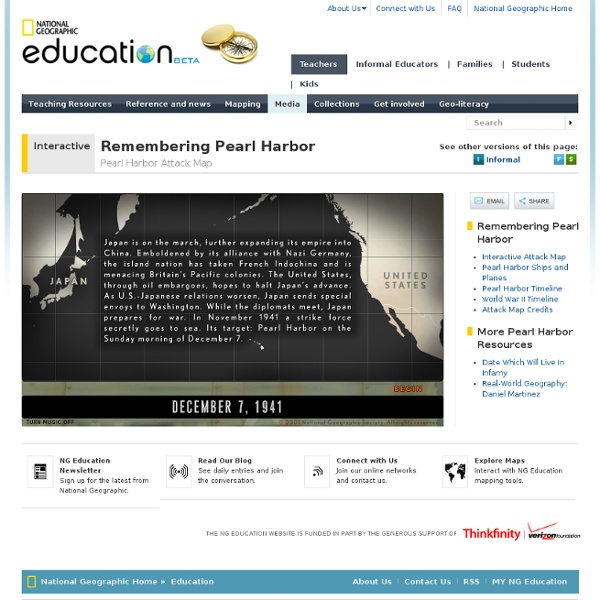



Pare Lorentz Film Center - Home The 1920's - Roaring Twenties - The Nineteen Twenties in History Fact Sheet: Pearl Harbor The Japanese attack on Pearl Harbor began at 7:55 am on December 7, 1941. Japanese naval forces compiled for the raid included 4 heavy aircraft carriers, 2 heavy cruisers, 35 submarines, 2 light cruisers, 9 oilers, 2 battleships and 11 destroyers. The attacking forces came in two waves, the first consisting of 183 aircraft which included 40 torpedo planes, 49 level bombers, 51 dive bombers and 43 fighters. from left: USS Maryland and USS Oklahoma after the attack on Pearl Harbor. Battleships A warship used mainly for naval bombardment and protection of the fleet against air and surface attacks. Cruisers Smaller than a battleship, cruisers are mainly deployed to conduct raids and protect members of the task force from enemy ships with naval bombardment and gunfire. Destroyers Small, highly maneuverable and lightly armored. U.S. Service Killed Wounded Total Navy 2008 710 2718 Army 218 364 582 Marines 109 69 178 Civilians 68 35 103 Summary of U.S. Battleships Arizona sunk, total loss Minecraft U.S.
Where in the World? A Google Earth Puzzle - Alan Taylor - In Focus Looking at the world via Google Earth offers striking images of the diversity of our planet and the impact that humans have on it. Today's entry is a puzzle -- part 2 in a series (part 1 here), in which we challenge you to figure out where in the world each of the images below was taken. (Unlike part 1, we're making this one multiple choice.) Note that north is not always up in these pictures. Use j/k keys or ←/→ to navigate Choose: Can you identify where in the world this image was taken? Remembering Pearl Harbor: The USS Arizona Memorial Today the battle-scarred, submerged remains of the battleship USS Arizona rest on the silt of Pearl Harbor, just as they settled on December 7, 1941. The ship was one of many casualties from the deadly attack by the Japanese on a quiet Sunday that President Franklin Roosevelt called "a date which will live in infamy." The Arizona's burning bridge and listing mast and superstructure were photographed in the aftermath of the Japanese attack, and news of her sinking was emblazoned on the front page of newspapers across the land. The photograph symbolized the destruction of the United States Pacific Fleet at Pearl Harbor and the start of a war that was to take many thousands of American lives. Indelibly impressed into the national memory, the image could be recalled by most Americans when they heard the battle cry, "Remember Pearl Harbor." More than a million people visit the USS Arizona Memorial each year.
Pearl Harbor ORIGINAL PEARL HARBOR PHOTOS Never seen these before----must be somebody 's private pictures they saved all this time. These pic's are so clear....very sad....but, good that we can see them...... THE FELLOW WHO SENT THESE RECEIVED THEM FROM AN OLD SHIPMATE ON THE USS QUAPAW PEARL HARBOR December 7th, 1941 Pearl Harbor On Sunday, December 7th, 1941 the Japanese launched a Surprise attack against the U.S. Hawaii . Admiral Nagumo, hoped to catch the entire fleet in port. Would have it, the Aircraft Carriers and one of the Battleships Were not in port. Island , where it had just delivered some aircraft. Lexingtonwas ferrying aircraft to Midway, and the USS Saratoga and USS Colorado were undergoing repairs in the United States). In spite of the latest intelligence reports about the missing Aircraft carriers (his most important targets), Admiral Nagumo Decided to continue the attack with his force of six carriers and 423 aircraft. The first wave of a two-wave attack. Kaneohe and Ewa.
Documentary Tube – Watch Documentaries Online for FREE Salem Witchcraft: the Events and Causes of the Salem Witch Trials By Tim Sutter © 2000-2003 What caused the Salem witch trials of 1692? This question has been asked for over 300 years. Although it is a simple question, it does not have an easy answer. Salem Politics Salem Village had a very colorful history before the famous witch trials. Many of the Salem Village farming families believed that Salem Town’s thriving economy made it too individualistic. The Putnams were the leaders of the separatist group primarily because they owned the most farmland in Salem Village. Contracts for ministers during this period often provided them with a modest salary, use of a house, and free firewood. In October of 1691 a new Salem Village Committee was elected that was comprised mostly of Parris’ opponents. Cold Winter Days The Rev. After chores were done, there was little entertainment for Betty and Abigail. Reading was a popular pastime during the winter months. Betty Parris, her cousin Abigail Williams, and two other friends formed such a circle. Salem Witchcraft
Attack on Pearl Harbor: Ships, Heroes and Speeches Educated Nation | A higher education blog about news, humor, advice, and opinion on education, college degrees, university life and careers.